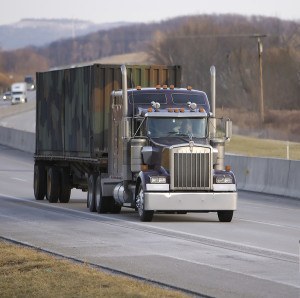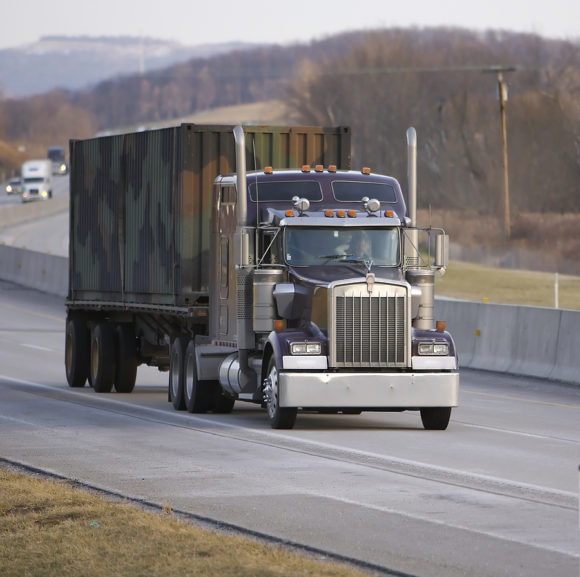Two Kansas State University civil engineers are working to make Kansas roads and highways safer by reducing the number and severity of vehicular crashes that involve large, cargo-carrying trucks.
Sunanda Dissanayake, associate professor of civil engineering, and Siddhartha Kotikalapudi, master’s student in civil engineering, India, are looking at five years’ worth of statistics about crashes involving commercial trucks. Although large trucks account for just 3 percent of registered vehicles in the U.S., truck-related crashes tend to be more severe than non-truck crashes.
“In 2009 the Federal Motor Carrier Safety Administration recorded that one out of every 10 traffic fatalities in the U.S. was a result from collisions involving large trucks,” Dissanayake said. “When you consider that between 30,000 to 35,000 people die each year in all motor vehicle crashes, it’s a pretty significant issue.”
Dissanayake and Kotikalapudi are currently in the second phase of their study, titled “Study of characteristics and evaluation of factors associated with large truck crashes,” which is being funded by the Mid-America Transportation Center.
Using information from the National Highway Traffic Safety Administration’s Fatality Analysis Reporting System — a comprehensive database with statistics about fatal crashes — the researchers analyzed truck-related fatalities throughout the nation for the first phase.
Currently, they are analyzing Kansas data from 2004-2008 and identifying the characteristics and factors that contributed to the crashes. A total of 18,919 crashes involving large trucks were recorded in the state throughout those five years. Of those accidents involving another vehicle, 81 percent ended with fatalities to occupants in the other vehicles, Dissanayake said.
To find the cause of these truck crashes, the engineers studied the driver, road, vehicle and environmental characteristics involved in accident.
Researchers found that among the 18,9191 truck crashes in Kansas, 13,260, or 73 percent, were contributory causes related to the truck driver.
Failing to give enough time and attention to the task being completed, such as switching lanes, passing another vehicle, etc. , was the biggest contributor to driver-related crashes.
Similarly, speeding, failing to yield the right of way, improper lane changes and following another vehicle too closely made up the top five contributors.
“Even though it may not feel that way, there are a lot of processes going on when you drive,” Dissanayake said. “Your brain is getting lots of information and processing it to determine what your action will be. So if a driver misses a detail or doesn’t give enough time to process that information related to what they are doing, it could lead to a crash.”
Other causes contributing to truck crashes included: environmental-related, such as animals or rain at 13 percent; road-related, such as ice or wet asphalt at 7.8 percent; and vehicle-related, such as falling cargo or defective brakes at 6.1 percent.
Researchers also found:
- Nearly 78 percent of truck-crashes happened during daylight and with no adverse weather conditions like rain or snow.
- A majority of the truck crashes happened between noon and 3 p.m.
- More truck crashes happened in locations with a high speed limit.
Dissanayake and Kotikalapudi are using these findings, as well as those from statistical models based on the data, to develop new safety guidelines and educational tools for truck drivers in an effort to reduce truck-related crashes.
Similarly, recommendations may also be made for new or amended legislation, both for the truck drivers and other drivers, Dissanayake said.
“Kansas recently introduced the Click It or Ticket seat belt law, for example,” she said. “The fine for not wearing a seat belt is $10. Some people may feel that a $10 fine is affordable and is not a deterrent to have their freedom compromised, so that might be an issue that needs to be looked into further.”
Dissanayake has studied several other traffic engineering and safety topics, including accidents on gravel roads and why older drivers are involved in more severe accidents.
Source: Kansas State University
Was this article valuable?
Here are more articles you may enjoy.


 Flooding in California Leads to Soaked Roads, Water Rescues and 1 Death
Flooding in California Leads to Soaked Roads, Water Rescues and 1 Death  LA Fires Push Insurers’ 2025 Disaster Losses to $107 Billion
LA Fires Push Insurers’ 2025 Disaster Losses to $107 Billion  Waymo to Update Software Across Fleet After Major Power Failure
Waymo to Update Software Across Fleet After Major Power Failure  Jump Trading Faces $4 Billion Terraform Administrator Suit
Jump Trading Faces $4 Billion Terraform Administrator Suit 